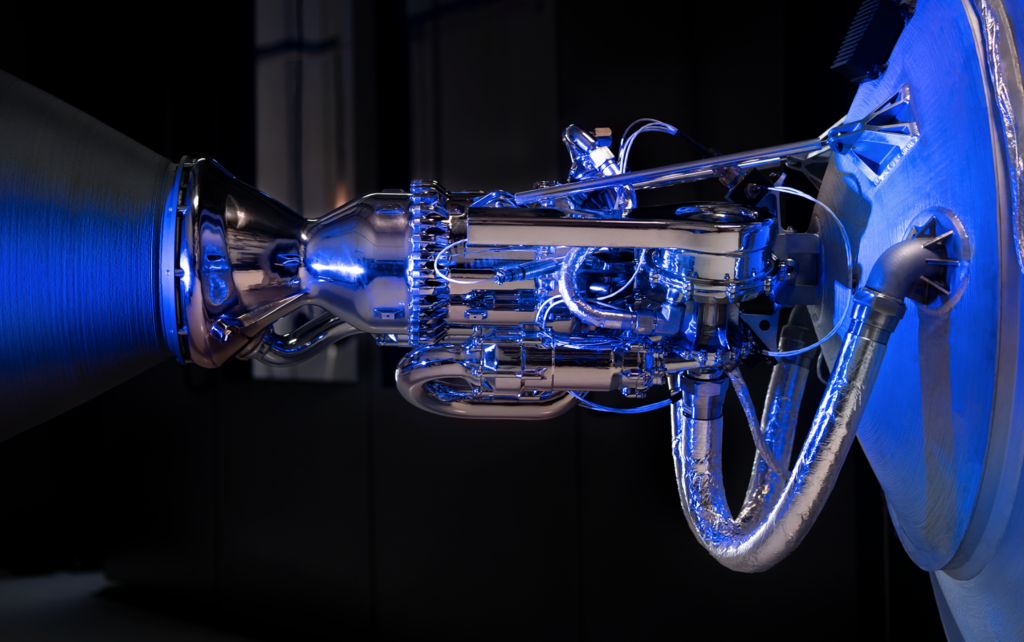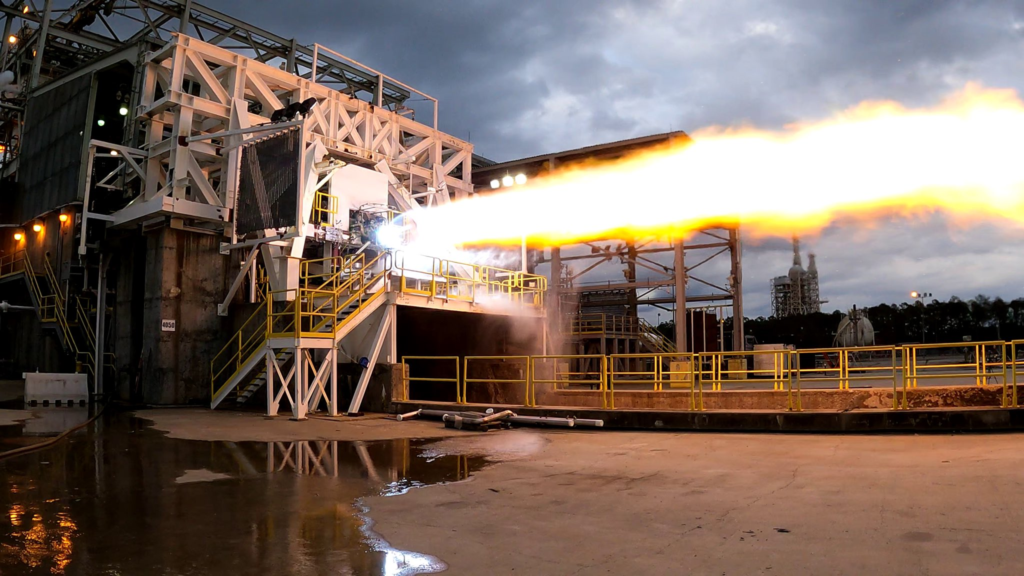
Significant Developments On Terran R’s Propulsion System
One of the most important components of any launch vehicle today is its propulsion system and primarily its main engines. Engines can single handedly have a major effect on the cost of the rocket, its payload capacity, results, and more. Here, if done successfully, companies can create engines that will last decades and save money and time in the process.
This complex yet vital process is exactly what Relativity Space is working on right now. Terran R is an entirely 3D printed rocket that will be fully reusable including its engines, first stage, second stage, and payload fairing. At the bottom, it features 7 Aeon R engines that together will produce over 3 million pounds of thrust at liftoff, all while being 3D printed as well.
In the past couple of days, CEO of Relativity Tim Ellis has shared a bunch of new test results and various developments of this exact engine. Very promising signs as the maiden flight of this next generation launch vehicle is scheduled not far away in 2024. Here I will go more in-depth into recent engine developments, why this engine is so special, what to expect in the future, and more.
Recent Updates

In the last month alone, it seems like progress has been non stop as Relativity ramps up work on this project. Starting just over a week ago on the 23rd, Tim Ellis tweeted saying, “It’s happening…rapid progress always so inspiring. This time, our entirely 3D printed Aeon R engine chamber at 62.5% power, 161,000 pounds of thrust equivalent, about double where the last test was. Looking prettyyyy legit!” This included images of the hot fire in progress. To put in perspective how fast they are developing and testing this engine, only 3 days before he tweeted again pointing out, “This may look like all our other engine tests but it’s not… first Aeon R full-scale hot fire test! goal by the team, this was 35% power level of the 268,000 lb max thrust. These brand new 3D printed engines will power Terran R. Massive push to get this done so quickly”
All of Relativity’s engines, Aeon 1, Aeon R, and Aeon Vac, are 3D-printed. The point of this is to try and enhance mission reliability by reducing part count in engine combustion chambers, igniters, turbopumps, reaction control thrusters, and vehicle pressurization systems. Not to mention, all Aeon engines use propellants of the future, liquid oxygen + liquid natural gas, which are not only one of the best for rocket propulsion, but also the easiest to eventually make on Mars, a major goal of the company. To date, Aeon has completed 500+ test fires.
One very important aspect of Aeon R engine development has to do with reusability. Terran R is working to provide both commercial and government customers affordable access to space, in LEO and beyond. It will do this by not losing anything but propellant each launch assuming the entire rocket is reused. By fusing 3D printing, artificial intelligence, and autonomous robotics, Relativity is printing its rockets’ structure and engines, significantly reducing touch points and lead times, simplifying the supply chain, and increasing overall system reliability.
Lastly, just yesterday Tim Ellis tweeted again mentioning, “Making material science breakthroughs to end the year – always testing new alloys in our lab, but this one cleared our strength targets for Terran R by 10%. Still more work to do, but great promise. Excited to see us accelerating the pace of development here!” Another example of the constant work and testing being done on this crucial engine.
Terran R Future

Now that we know more about some of the recent Aeon R engine developments, we can take a closer look at what Relativity has planned for the future with this ambitious rocket. Recently in October just months ago, Relativity detailed its plans to operate one of the largest rocket engine test facilities in the United States. Through an agreement with NASA, Relativity is significantly expanding its facilities and infrastructure at NASA’s Stennis Space Center in Hancock County, Mississippi. The new facilities will support testing of Relativity’s entirely 3D printed Aeon R engines.
Specifically, Relativity will utilize over 150 additional acres within the Stennis Test Complex, with testing infrastructure for its Aeon R engines being built from the ground up on previously unutilized land north of the A and E Test Complexes. Relativity has begun ground clearing work for several new engine test stands, a full scale second stage stand, office buildings, and a vehicle hangar. The company is already underway testing Aeon R components across Relativity’s E2 test complex, with work to build the first Aeon R engine and turbopump assembly and begin thrust chamber assembly tests for its Aeon R engines underway. Full Aeon R engine tests are set to occur in late 2023 at Relativity’s newly announced facility expansions.
Relativity currently occupies several operational facilities at Stennis, which include four exclusive-use test stands in the E4 area used for Terran 1 stage testing and Aeon 1 engine testing, two exclusive-use stands in the E2 area used for Aeon 1 engine and Aeon R component tests, and one cell on the E1 test stand available through a Reimbursable Space Act Agreement for Aeon R engine tests. Additionally, Relativity has expanded into several buildings that house its rapidly growing team and test control operations. These facilities have enabled more than 2,000 engine tests, multiple successful mission duty cycles, and a fully-integrated stage testing of a 3D printed orbital flight article – which is not only a first for Relativity but for the entire aerospace manufacturing industry.
“We’re looking forward to writing some new history at Stennis through an incredibly large new expansion of development and test capabilities. We’re honored to partner with NASA and are grateful for their support. We look forward to growing our Stennis-based team, who will be pivotal in our success of meeting many more first-ever milestones as we scale our Terran R program” said Tim Ellis.
As a two-stage rocket with a 5-meter payload fairing, Terran R will be entirely reusable and capable of launching 20,000kg to low Earth orbit (LEO). Terran R is made possible through the company’s proprietary 3D printing process, which utilizes software-driven manufacturing, proprietary, high-performance next generation materials, and unique design geometries that are not possible to achieve in traditional manufacturing. Relativity’s Stargate printers, the largest in the world, can produce Terran R as well as Terran 1.
Combined with the ability to launch 20X more payload than Terran 1, Terran R is very ambitious. However, with satellite technology advancements, demand for bandwidth soaring, and satellite constellations representing the largest part of the growing market, Terran R was accelerated to try and accommodate the growing demand for large constellation launch services, and the company’s growing pipeline of commercial interest. To date, Relativity has signed five customer launch contracts for Terran R, including a multi-launch agreement with OneWeb and its first commercial mission to Mars with Impulse Space totaling more than $1.2 billion in backlog. Besides more development on Aeon R engines and their infrastructure, the teams at Relativity are also working on the printers for this massive rocket.
“Large-scale products that are designed to fly will inevitably be 3D printed,” said Tim Ellis, cofounder and CEO of Relativity Space. “The lighter a product is, the better it performs, and when 3D printing that product, it’s also faster and more cost-effective to produce with each successive improvement. The compounding rate of progress is high, and we are still in the early days of what printing can achieve. We see 3D printing as an automation technology that has the power to change the pace of innovation in manufacturing, which is why we’ve invested in building our own proprietary tech stack from day one. Stargate printers are designed to unlock rapid iteration, which opens up opportunities for innovation in large-scale manufacturing products. What would take traditional aerospace and space manufacturers years to develop and build, will be reduced down to months due to a highly adaptable, scalable, and automated process, made possible through software-driven manufacturing.”
“Iteration empowers innovation not only in our rocket design, but also in our own Stargate printers,” said Scott Van Vliet, SVP of Software Engineering. “In its short history, Relativity has made great strides in evolving its core 3D printing technology, but Stargate 4th Generation printers are our most innovative leap yet. We’re fundamentally changing the way our factories are designed and operating, and by flipping the script and going horizontal, we’re radically increasing our capacity for scale. Being a software-driven manufacturing company allows us to achieve unique product features, such as integrated pad-ups and domes, with radical flexibility.”
Conclusion
Relativity Space is working in overdrive as they continue to make Aeon R engine progress at a blistering pace. This comes in addition to the first launch of Terran 1 just weeks away. All of which in an effort to get Terran R flying not long from now in 2024. We will have to wait and see how it progresses and the impact it has on the space industry.
